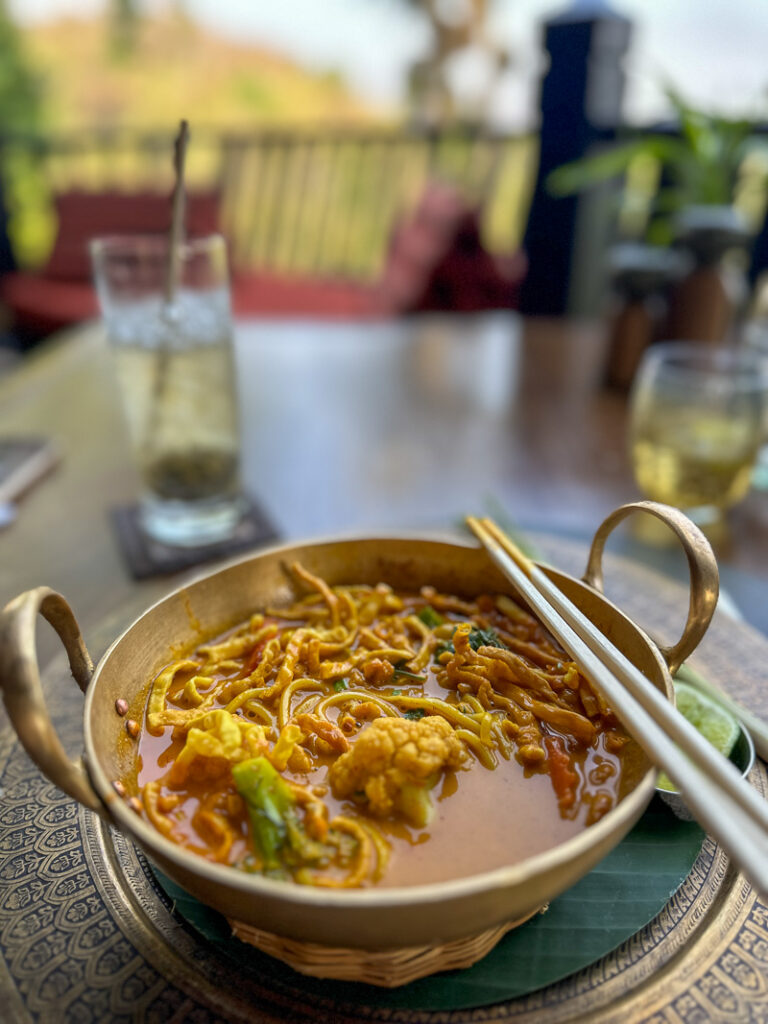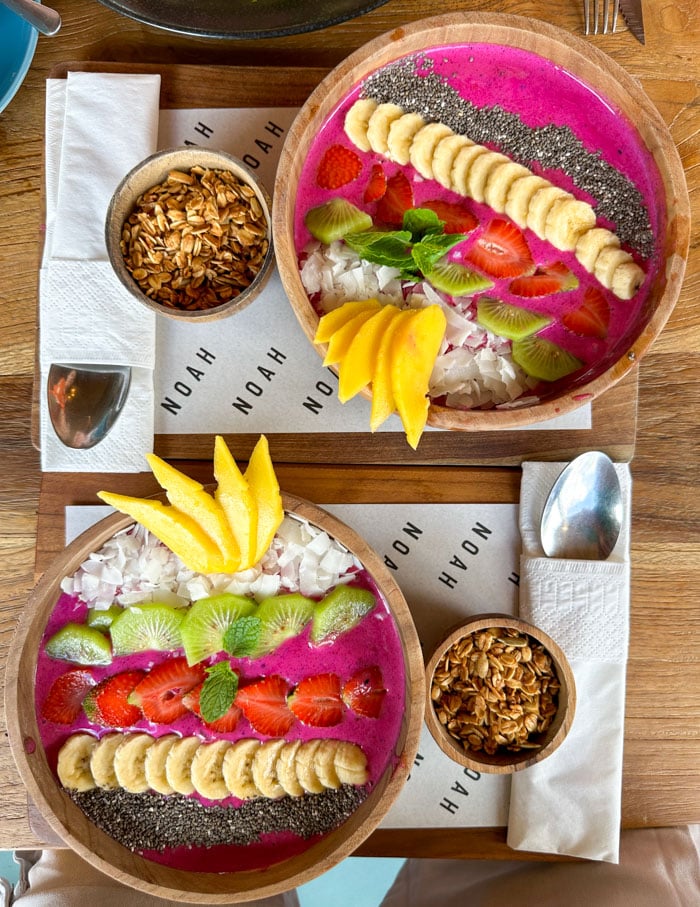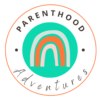How to Travel in Southeast Asia with a Peanut Allergy
I’ve been traveling the world for over a decade now, visiting over 60 countries. When my partner and I decided to start a family, we knew we wanted to keep traveling with my son. The only wild card? It turns out he has some food allergies to contend with, including peanut.
Prior to having my son, I spent several years living and traveling in Asia, the peanut capital of the world, without ever thinking about food allergies. Could we safely and responsibly bring my son to the region I have come to love most?
With some advance planning, we’ve avoided any allergic reactions in Singapore, Thailand, and Indonesia so far. Here’s what to know about traveling in Southeast Asia with a peanut allergy:
Travel with Translations

Peanut allergies don’t seem to be a thing in Southeast Asia, but that doesn’t mean locals have never heard of them, particularly in areas that receive lots of tourists like Bali or Thailand. We would always show a translation to the staff before ordering, and prioritized restaurants and dishes that didn’t have peanut in them.
In each country we visit, we make sure to travel with translations. I have contacts in each country and have been able to ask them to write them for us, but in case you need yours to be more specialized with additional allergens, you can typically purchase on Etsy.
I’m quite literal with our translations, stating that our son could die if he has any peanut or peanut oils in his food. Nobody wants to be responsible for a little baby (or adult I’m sure) having an allergic reaction, and I found that people generally took it seriously.
Here’s the peanut translation in Thai:
🥜 ฉันแพ้ถั่วลิสงอย่างแรงถ้ากินหรือสัมผัสอาจถึง ” ตาย” ได้ กรุณาอย่าใส่ถั่วลิสงและเครื่องปรุงที่มีส่วนผสมของถั่วลืสงในอาหาร
กรุณาอย่าใช้ช้อนหรือเครื่องปรุงและเครื่องใช้ที่อาจมีถั่วลิสงติดอยู่
กรุณาอย่านำถั่วลิสงวางใก้ลหรือสัมผัสกับเครื่องดื่ม
ขอบคุณ
And Bahasa Indonesian (note this references our child specifically) :
🥜 Anak saya mengalami allergy kacang tanah yg berat. Dia tidak bisa makan minyak dari kacang tanah, saus kacang, dan kacang tanah. Dia bisa meninggal karena kacang.
Consider downloading Google translate’s free offline version so that you can communicate further with restaurant staff if needed. If they don’t seem to be taking it seriously enough or seem confused, simply thank them and find another place to eat.
Learn the Names of Dishes with Peanut

Whether you’re avoiding just peanut or have any other dietary restrictions, it’s crucial to know what to steer clear of.
Get familiar with the names of dishes that are a big no-no for you. In Thailand, that will include Massaman or Khao Soi curry, satay (which comes with peanut sauce), and generally papaya salad and pad Thai, which come with a peanut garnish. Depending on the severity, you might be fine just asking them to leave off the peanuts on a dish, but in many cases, the same mortar and pestle or pan might be used for cooking everything, so we found it best to avoid these dishes completely for my son.
In Indonesia, Warungs are best avoided. They might have cross contamination as well, and it’s possible that those making the food might even have peanut oils or sauces that they might not realize are even in the bottles.
We also completely avoided street food in Thailand and Bali and only fed my son western dishes. We stayed in resorts that were higher end as well so that we could make sure they had restaurants onsite that were familiar with allergies, and we checked with them before even booking. I highly recommend letting any hotel you’ll be staying at know of your children’s allergies before you check in, and continuously reminding the wait staff whenever you sit down to eat.
I also noticed that higher end hotels in Southeast Asia almost always noted allergens on their menus. You can find a list of the ones we’ve had zero issues at here.
Consider Avoiding Local Food Completely

Listen, I get it – missing out on mouthwatering street food is tough. But when it comes to your health, it’s better to be safe than sorry. We erred on the side of an abundance of caution and didn’t feed our son local food for the most part. If we did, it wasn’t at warungs or small local eateries where one wok is used to cook all the dishes.
We took this approach after speaking with friends and reading other blog posts about traveling in Asia with peanut allergies. Those who had issues would often eat local food at smaller more remote places, but didn’t have as severe of an allergy and could take a bit of a risk. Those with more severe allergies would avoid local food completely and one family even stated they would have their son eat McDonald’s while they went for the local food.
Since we’re not sure the extent of my son’s allergy, we stuck to grilled fish and veggies, grilled chicken, fruit, and rice. We didn’t make it too complicated. In places that felt a bit more trustworthy, we’d also get smoothie bowls for him (provided they assured us they used different blenders for peanut based smoothies or would wash thoroughly). We also had snacks from home along in case we couldn’t be sure about what we were able to find.
Another post I read suggested taking the food and placing some on your skin to see if there’s a reaction before fully digging in if you have concerns.
Supermarkets can also be a safe haven. Take your time browsing the aisles and snap pics of oil labels with your translation app.
Consider Degree of Remoteness when Booking
Although I’ve had wonderful experiences traveling quite remotely in Southeast Asia myself, food options have often been quite limited. Sticking to places that receive more tourism like Bali meant that locals would have heard of a peanut allergy before, and might already be taking precautions at their hotels and restaurants for those who have these issues to consider.
We were even asked at a restaurant in Singapore before we ordered if we had any allergies, which was great, because they did have peanut in some dishes that I wouldn’t have expected.
If you do go remote, bring more food along with you from home (protein bars, dehydrated noodles, or even backpacker just add water meals) and stick to fruit and things you’re sure don’t have peanut in them. The more cautious you are with your food, honestly, the more adventurous you can be with your destinations.
Take Spare Medication
Always, always, always carry extra meds, and brief those you’re with on how to use them if necessary. We have two junior epipens and oral steroids with us at all times in the diaper bag. Trust me, you don’t want to be stuck without your EpiPen in the middle of nowhere, and you want to have a backup in case you can’t get another one abroad. And don’t forget the paperwork – some airlines and countries might need proof of your meds, so cover your bases.
In a nutshell (pun intended), it’s all about being prepared and cautious. You can’t eliminate every risk, but with a little planning, you can enjoy your travels to the fullest.
Safe travels!








Thanks for sharing this! My toddler has a peanut allergy, and it can be overwhelming thinking how to keep her safe. I was just at a wedding in Mexico and even though the bride talked to the caterer about avoiding peanuts and we were just eating tacos for dinner, two of the kids with peanut allergies had major reactions. It’s scary but I love the idea of having the translation cards!
That is so disappointing about the tacos! And how strange as well. I don’t usually think of Mexican food as having peanut in it, but I’m glad to say that people really took it seriously everywhere we’ve gone so far.